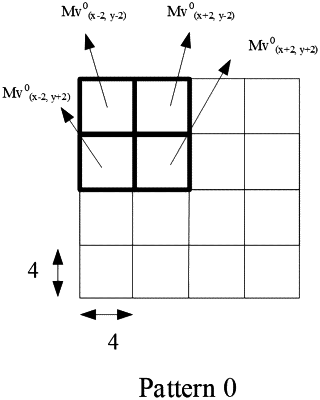| CPC H04N 19/137 (2014.11) [H04N 19/105 (2014.11); H04N 19/119 (2014.11); H04N 19/176 (2014.11); H04N 19/186 (2014.11)] | 14 Claims |

|
1. A method for processing video data, comprising:
deriving one or more motion vectors for a first set of sub-blocks belonging to a first dividing pattern of a current video block of a video; and
performing, based on the one or more motion vectors, a conversion between the current video block and a bitstream of the video,
wherein the deriving the one or more motion vectors for the first set of sub-blocks is based on motion vectors of a second set of sub-blocks, wherein the second set of sub-blocks has a second dividing pattern different from the first dividing pattern;
wherein the one or more motion vectors for the first set of sub-blocks comprises MV1 and the motion vectors of the second set of sub-blocks comprise MV01, MV02, MV03, . . . and MV0K, and wherein K is a positive integer; and
wherein MV1 is derived by one of:
MV1 =max (MV01, MV02, MV03, . . . , MV0K), wherein max(⋅) is an operation that selects a maximum value from a plurality of input values;
MV1 =min (MV01, MV02, MV03, . . . , MV0K), wherein min(⋅) is an operation that selects a minimum value from a plurality of input values;
MV1=MaxAbs(MV01, MV02, MV03, . . . , MV0K), wherein MaxAbs(⋅) is an operation that selects a maximum absolute value from a plurality of input values; or
MV1=MinAbs(MV01, MV02, MV03, . . . , MV0K), wherein MinAbs(⋅) is an operation that selects a minimum absolute value from a plurality of input values.
|